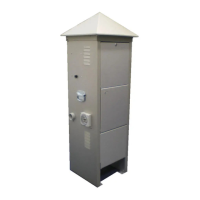
Do you have a question about the Ecotech HiVol 3000 and is the answer not in the manual?
| Brand | Ecotech |
|---|---|
| Model | HiVol 3000 |
| Category | Measuring Instruments |
| Language | English |
Hazardous voltages and precautions for safe operation.
Essential safety practices and guidelines for operation.
Details of the 12-month warranty on parts and labour.
Procedure for factory repairs, including authorization and required information.
Procedure for handling damaged goods and required documentation.
Process for reporting shortages or other discrepancies in shipments.
Explanation of symbols used on Ecotech equipment per IEC and ISO standards.
Compliance with EC directives for emissions, immunity, and electrical safety.
Essential safety practices and guidelines for operation.
Equipment rating, voltage, frequency, and environmental conditions.
Overview of the HiVol 3000's capabilities for particulate and meteorological monitoring.
Details on volumetric flow rate range, accuracy, and repeatability.
Sensor specifications for ambient temperature and barometric pressure.
Voltage, frequency, and power connector details for the sampler.
Recommended ambient temperature and humidity ranges for operation.
Case dimensions, inlet materials, weight, and glossary of terms.
Glossary of terms and acronyms used in the manual.
Historical development of air quality standards for PM10 and PM2.5.
Evolution of high-volume air sampling techniques and the HiVol sampler.
Explanation of how the HiVol 3000 collects and measures airborne particles.
Procedure for sampling Total Suspended Particulates.
Procedure for sampling PM10 and PM2.5 using size selective inlets.
Primary standards for PM10 and PM2.5, including reference conditions.
Objectives for PM10 concentration and allowable exceedances.
Configuration requirements for EPA designated reference methods.
Details on the sampler's aluminium enclosure, doors, and fasteners.
Information on the induction motor, silencers, and bearings.
Description of the inlet funnel, joining sleeve, and tubing.
Function and location of the precision mass flow sensor.
Explanation of the Variable Speed Drive (VSD) for flow rate regulation.
Details on electronics, control panel, power inlet, and filter cassette.
Location and function of the temperature sensor for flow control.
Procedures for checking delivery, inspecting for damage, and basic testing.
Steps for assembling the inlet hood, SSI, and muffler.
Detailed steps for attaching and adjusting the inlet hood.
Diagram and instructions for securing the inlet hood.
Steps for assembling the optional PM10 or PM2.5 Size Selective Inlet.
Instructions for installing the optional muffler for noise reduction.
Procedure for connecting optional wind speed/direction sensors or rain gauges.
How to connect an external trigger for remote activation.
Criteria for selecting appropriate sampling sites for representative data.
Steps for securely mounting the sampler on a level surface.
Detailed instructions for connecting the sampler to a power source.
Diagram illustrating the HiVol power connection with safety devices.
Guidelines for connecting exhaust tubing for noise reduction.
Instructions for installing the optional muffler.
Choosing appropriate filter media for Total Suspended Particulates sampling.
Choosing appropriate filter media for PM10 and PM2.5 sampling.
Steps for inspecting, coding, and conditioning filter papers.
Procedure for installing a filter into the sampler cassette.
Steps for connecting power, switching on, and initial system check.
Overview of the control panel, data logging, and input connectors.
Explanation of conditional sampling parameters and continuous operation setup.
How to navigate menus and operate the sampler controls.
Procedure for modifying sampler parameters via the menu system.
Description of data types used for menu operands.
Overview of the information displayed on the main screen.
Quality assurance procedures before starting a sampling run.
Steps for installing a filter and starting a sampling period.
Procedures for ending a sampling period and removing the filter.
How to record data and reset the logger for the next cycle.
Diagram illustrating the sampler's menu hierarchy.
Displays current sampler status and parameter readings.
Overview of parameters configurable via the Setup menu.
Setting programmable timer options for sampling periods.
Setting wind sector and speed parameters for conditional sampling.
Configuring parameters for external triggering of the sampler.
Setting data averaging/storage period and clearing logged data.
Setting the current date and time for the sampler.
Configuring flow rate limits for alarm generation.
Controls for sampler restart after errors like 'Filter Blocked'.
Operating the sampler in manual mode for checks and verification.
Accessing the calibration functions for sensors and flow rate.
Steps for calibrating the flow rate using an orifice plate or transfer standard.
Diagram illustrating the flow rate calibration setup.
Considerations for ambient temperature and pressure during calibration.
How to use the orifice plate calibration chart for flow determination.
Formula and example for calculating pressure drop across the orifice plate.
Step-by-step guide for performing flow rate calibration.
Procedures for calibrating ambient temperature and barometric pressure sensors.
Detailed steps for calibrating the temperature sensor.
Detailed steps for calibrating the barometric pressure sensor.
Steps for connecting the HiVol to a PC using a serial cable.
Installation and usage of the Ecotech Downloader software.
Instructions on how to launch and operate the data downloader program.
Using terminal emulators for data download.
Overview of how sample volume and mass concentration are calculated.
Explanation of sample volume calculation and correction to STP.
Explanation of how mass concentration is determined.
The formula used for calculating mass concentration.
List of tools required for general maintenance tasks.
Recommended maintenance tasks and their frequency.
Inspection of power cords, structure, housing, and gaskets.
Verifying the operation of the automatic flow compensation.
Procedure for cleaning the filter cassette and supporting structure.
Cleaning and regreasing the collection shim in the SSI.
Schedule for cleaning the Size Selective Inlet components.
Guidelines for TSP concentration-based cleaning intervals.
Instructions for applying grease to the Teflon Ring of the SSI.
Procedure for re-zeroing or adjusting the flow sensor.
Steps for replacing the flow sensor, including panel removal.
Instructions for safely removing the rear access panel.
Steps for reassembling the sampler after flow sensor replacement.
Accessing and understanding hidden menu parameters for advanced settings.
